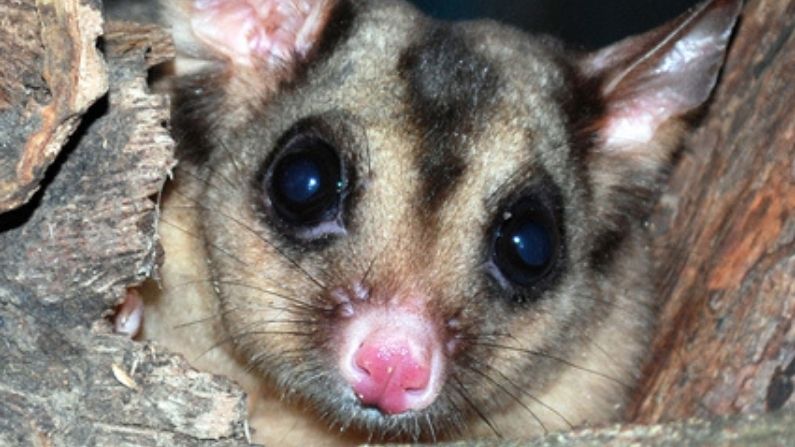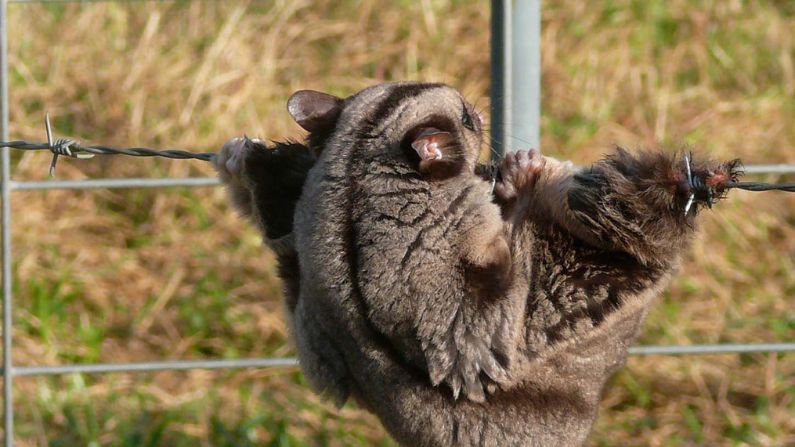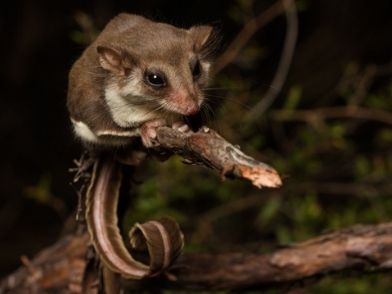Mahogany
glider
© Daryl Dickson
The mahogany glider is named for its rich brown mahogany colour and the importance of the swamp mahogany tree, Lophostemon suaveolens, in its habitat. The scientific name Petaurus gracilis means slender rope dancer. They have been known to glide up to 60 metres, with an average glide distance of 30 metres.
Quick facts
COMMON NAME:
Mahogany glider
SCIENTIFIC NAME:
Petaurus gracilis
FAMILY:
Petauridae
QLD CONSERVATION STATUS:
Endangered
NATIONAL CONSERVATION STATUS:
Endangered
How we help the mahogany glider
Since the mid-1990s, Wildlife Queensland Cassowary Coast — Hinchinbrook Branch, together with Wildlife Queensland Townsville Branch, Terrain NRM, and the Mahogany Glider Recovery Team, has been actively working to save the endangered mahogany glider (Petaurus gracilis) from extinction. Read about the Mahogany Glider Recovery Project here.

Did you know?
Mahogany gliders use their long tails to stabilize them as they glide.
 © Daryl Dickson
© Daryl Dickson
Threats to the mahogany glider
- Habitat fragmentation
- Habitat clearing and loss of mature den trees
- Habitat degradation (woody weeds & rainforest incursion into the very limited existing habitat)
- Barbed wire fences (many gliders die a slow and terrifying death trapped by their gliding membrane on barbed wire)
- Feral predators such as cats and dogs
Home range and family groups
Mahogany gliders are territorial animals within their home range and will seasonally utilize between 2-9 den trees within their territory. Unlike squirrel and sugar gliders they do not den with larger family groups and will only share their dens with a breeding partner and the immature young of the season. They often den alone. Dens are found in mature trees and are often lined with eucalypt leaves.
In a non-fragmented habitat, the average home range size for a male is 19.25 hectares, for a female is 20.34 hectares and for a coupled male and female 23.15 hectares. In contrast in fragmented habitats the home range size of a male is 11.05 hectares, female 6.80 hectares, and a coupled male and female 11.60 hectares.
Natural predators in their range are owls, pythons, and goannas.
Distribution
The mahogany glider has the smallest distribution of all glider species in Australia. They are found in a very restricted area of the Far North Queensland coast, primarily below 100 m elevation. They are known to occur between Ollera Creek (40 km south of Ingham) and Hull River near Tully.
Description
The mahogany glider is one of Australia’s most threatened mammals. It is found only in a very restricted area of coastal woodland in far north Queensland. First specimens were recorded in 1883, and then all record of the species laid unnoticed by science for more than 100 years until their rediscovery in 1989. The management of this species and its habitat require immediate and ongoing attention to prevent their continued decline towards extinction.
The mahogany glider looks similar to the squirrel glider but has a longer, very slender tail. This glider is significantly larger than the squirrel glider.
Body measurements:
- Head-body length, males 230-275 averaging 254 mm, females 225-270 averaging 248 mm
- Tail length, males 335-395 averaging 370 mm, females 345-405 averaging 377 mm
- Weight, males 330-500 averaging 407 grams, females 310-454 averaging 365 grams
Unlike the squirrel glider, the mahogany glider’s colour can vary from overall mahogany brown to grey-brown on their backs, with a black dorsal stripe. The colour on the belly also varies from cream in young animals to buff and apricot colour.
The gliding membrane extends from the wrist to the ankle.
Signs
- Droppings are 17 mm x 5 mm, often with gum bands but extremely difficult to locate in tropical forests.
- When spotlighted they have a pale red eyeshine.
Sounds
- They are primarily silent animals and rarely call; calls consist of coarse grunts ‘na-when’, ‘hoy’, ‘urga’, ‘aargh’ and ‘tzzz-tzzz’ (young) sound. Their ‘Nwarr’ call is similar to the squirrel glider.
Ecology and behaviour
Habitat
- The glider’s habitat is tropical lowland open eucalypt and melaleuca woodland.
- Historically this habitat has been shaped and maintained by fire.
- Within this region, mahogany glider habitat has been reduced by more than 50% from its historic range.
Breeding
- Breeding season usually occurs from April to October. Males breed with one female per breeding season, and they generally have 1 litter per year. They may raise a second litter if the first is lost. Litter size is usually two young, which are weaned at 4-5 months.
- Data is still being collected to define the longevity of this species in the wild.
- They reach sexual maturity at 12-18 months of age.
Diet
The mahogany glider feeds on nectar, pollen, plant exudate, insects and honeydew, and Acacia seed arils.
- They require a wide range of plant species that produce food at different stages of the year to survive.
- Plant exudates include acacia gum and wattle, albizia and grass tree sap.
- Honeydew is a sugary coating on leaves made by scale insects.
- Acacia seed arils are the protein-rich stringy structures by which seeds hang in the pod.
- They have been seen breaking open the leaf nests of green tree ants to steal the stored arils (high in protein) of acacia seeds and possibly the ant eggs.
- They will travel on average 1.5 kms a night in search of food.
- They spend 44% of their time feeding and foraging for food.
Mitigation practices
- Conservation of remaining habitat and habitat corridors
- Restoring connectivity – creating corridors between isolated habitat
- Establishment of appropriate fire regimes
- Woody weed management
- Replacement of barbed wire with plain wire
- Community Education & awareness
- Installation of den boxes in revegetation and den deficient areas
More information
Publications & papers
- Isaac, J. L., Parsons, M., and Goodman, B. A. (2008). How hot do nest boxes get in the tropics? A study of nest boxes for the endangered mahogany glider. Wildlife Research 35: 441-445.
- Parsons, M., and Latch, P. (2007). Recovery plan for the mahogany glider Petaurus gracilis. Report to Department of the Environment, Water, Heritage and the Arts, Canberra. Environmental Protection Agency, Brisbane.




